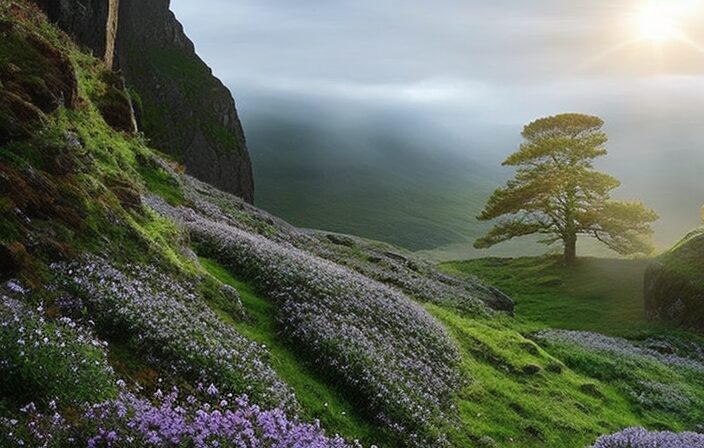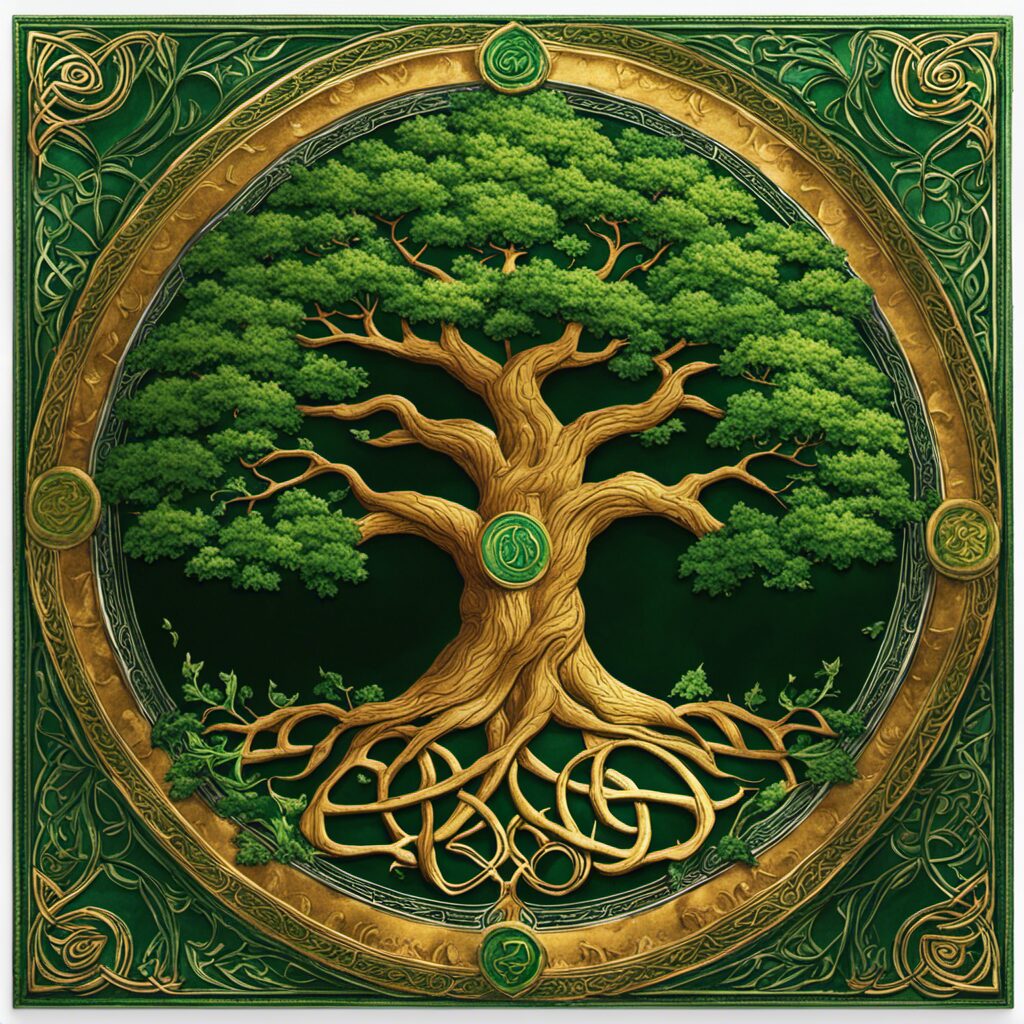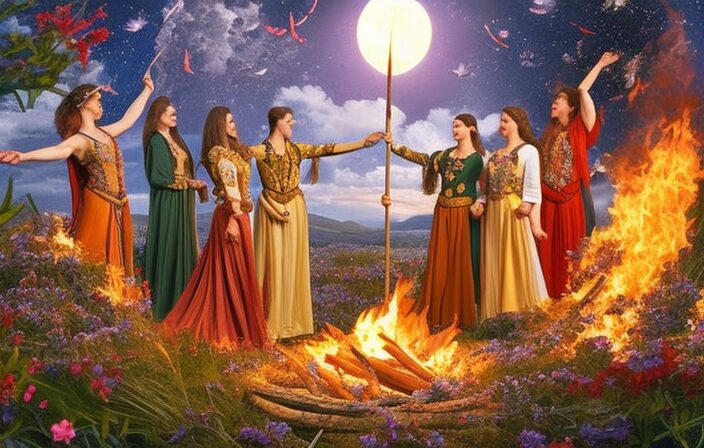The Celtic calendar is a significant aspect of ancient Celtic culture, reflecting the intricate relationship between humans and the natural world. Derived from an amalgamation of astronomical observations and agricultural practices, this calendrical system provides insight into how the Celts perceived time and organized their societal activities accordingly.
By examining the origins, structure, and symbolism of this calendar, along with its connection to nature through festivals and astrology, one can gain a deeper understanding of the profound influence that the natural world had on Celtic society.
Key Takeaways
- The Celtic Calendar is derived from astronomical observations and agricultural practices, developed by ancient Celtic cultures.
- The calendar consists of solar and lunar months and marks important milestones in the agricultural cycle.
- It celebrates the changing seasons, with specific festivals and rituals associated with each season.
- The calendar highlights the importance of solstices and equinoxes, reflecting the deep connection between humans and nature.
The Origins of the Celtic Calendar


The origins of the Celtic calendar can be traced back to ancient Celtic cultures and their understanding and observation of natural phenomena. The Celts were deeply connected to nature, and they believed that the cycle of seasons and celestial events played a significant role in their lives. They developed a lunar-solar calendar system that was based on the movements of the moon and the sun.
This calendar consisted of both solar and lunar months, with each month corresponding to specific agricultural activities or cultural celebrations. The Celtic calendar was closely tied to their agricultural practices as they relied heavily on farming for sustenance. Each month marked important milestones in the agricultural cycle, such as planting, harvesting, or preparing for winter.
The Celts also celebrated various festivals that were linked to different phases of the natural world. These festivals often involved rituals, feasts, and gatherings where communities would come together to honor deities associated with nature. The Celtic calendar not only served practical purposes but also had deep cultural significance for the Celts. It reflected their close connection with nature and their belief in its power and influence over human life.
Through this calendar system, they sought to align themselves with natural rhythms and cycles, ensuring harmony between humanity and the environment that sustained them. Overall, the origins of the Celtic calendar lie in ancient Celtic cultures’ understanding of natural phenomena and their desire to celebrate these through various cultural festivities throughout the year.
The Four Seasons in the Celtic Calendar


Seasons in the Celtic calendar are traditionally associated with specific agricultural activities and celestial events. The Celtic wheel, also known as the Wheel of the Year, divides the year into four main seasons: Imbolc, Beltane, Lughnasadh, and Samhain. These seasons mark key points in the agricultural cycle and are deeply rooted in ancient traditions.
Imbolc, celebrated around February 1st, is associated with the beginning of spring and marks the first signs of new life in nature. It is a time for purification rituals and offerings to honor Brigid, the goddess of fertility and healing.
Beltane falls on May 1st and represents the height of spring. This season is characterized by fertility rituals and celebrations to ensure a prosperous harvest. Bonfires were traditionally lit to purify the land and protect against evil spirits.
Lughnasadh takes place around August 1st and marks the beginning of autumn. It is a time for harvesting crops and giving thanks for abundance. Festivals often included athletic competitions to celebrate Lugh, the god associated with skill and craftsmanship.
Samhain occurs on October 31st or November 1st and represents winter’s arrival. It is a time when it was believed that the veil between worlds was thin, allowing communication with ancestors. Rituals were performed to honor those who had passed away.
These seasonal markers demonstrate how deeply connected ancient Celtic traditions were to their natural surroundings. They provide insights into how ancient communities celebrated nature’s cycles while ensuring their survival through agricultural practices tied to these celestial events.
The Importance of Solstices and Equinoxes


This discussion will explore the seasonal significance of solstices, cultural celebrations and equinoxes, and the connection between nature and the calendar.
Solstices mark important astronomical events when the tilt of Earth’s axis is most extreme, resulting in either the longest or shortest day of the year.
Equinoxes, on the other hand, occur when day and night are roughly equal in length.
These celestial events have been observed and celebrated by various cultures throughout history, often reflecting a deep connection between human societies and their natural surroundings.
Seasonal Significance of Solstices
Solstices hold significant seasonal importance in the Celtic calendar due to their alignment with celestial events. The solstices, which occur around June 21st and December 21st each year, mark the longest and shortest days of the year respectively. These astronomical events have been celebrated by various cultures throughout history, including the Celts.
The celebratory traditions associated with solstices in the Celtic calendar reflect their historical origins and connection to nature. For example, during the summer solstice known as Litha, bonfires were lit to honor the sun and its life-giving properties. Similarly, during the winter solstice or Yule, evergreen plants were used as symbols of hope and rebirth amidst the darkness of winter.
These traditions highlight how solstices played a central role in Celtic culture by marking important seasonal transitions and honoring natural phenomena through ritualistic practices.
Cultural Celebrations and Equinoxes
Cultural celebrations that coincide with the equinoxes are observed by various societies around the globe. These cultural traditions are deeply rooted in the significance of celestial events and serve as a way for communities to honor and connect with nature.
Equinox celebrations offer an opportunity for people to mark the changing seasons and acknowledge the balance between light and darkness. Many cultures organize rituals and ceremonies during equinoxes to express gratitude for harvests or to seek blessings for future crops. Equinox festivals frequently involve communal gatherings, music, dances, and feasts, fostering a sense of unity within communities.
These cultural practices highlight the important role that celestial events play in shaping human societies. By honoring these natural phenomena through traditions passed down from generation to generation, individuals reaffirm their connection to the natural world and its rhythms.
Connection Between Nature and Calendar
The connection between celestial events and the organization of time can be seen in various societies’ calendars. In Celtic rituals, the natural cycles played a significant role in determining the passage of time and marking important occasions.
The Celts were deeply attuned to the rhythms of nature, and their calendar reflected this connection. The changing seasons, solstices, equinoxes, and lunar phases all had specific meanings and were observed through various rituals and ceremonies.
For example, the festival of Samhain marked the end of the harvest season and was celebrated on October 31st. This event not only marked the beginning of winter but also served as a time for honoring ancestors and preparing for the dark months ahead.
The Role of Nature in Celtic Festivals


Nature plays a pivotal role in Celtic festivals, as it influences the timing and themes of these celebrations. The Celts were deeply attuned to the natural world around them, and they believed that nature had a profound impact on their lives. This belief manifested itself in their cultural celebrations, which were often closely tied to the cycles of the seasons and the agricultural calendar.
The role of nature in Celtic festivals can be seen in several ways:
-
Timing: Celtic festivals were typically held at key points in the agricultural calendar, such as harvest time or the beginning of spring. These dates were determined by observing natural phenomena such as the position of the sun or moon, or the blooming of certain plants.
-
Themes: Many Celtic festivals revolved around themes related to nature and its cycles. For example, Beltane celebrated the coming of summer and fertility, while Samhain marked the end of harvest and the beginning of winter.
-
Rituals: Nature was also central to many rituals performed during Celtic festivals. These rituals often involved offerings to gods or spirits associated with specific aspects of nature, such as rivers or forests.
Overall, nature played a fundamental role in shaping Celtic festivals. These cultural celebrations served not only as opportunities for communal gathering and celebration but also as ways for people to connect with and honor the natural world that sustained them.
Animals and Plants in Celtic Astrology


Animals and plants held significant symbolic meanings in the astrological system of the Celts. Celtic animal symbolism and tree astrology played vital roles in their understanding of the natural world. The Celts believed that each animal and plant possessed specific traits and characteristics that could be used to interpret human behavior, personality traits, and destiny.
Celtic animal symbolism was based on the belief that animals had spiritual qualities that could influence individuals born under certain signs. For example, those born under the sign of the stag were believed to possess grace, strength, and determination, while individuals associated with the bear were thought to embody power, protection, and healing abilities.
Similarly, Celtic tree astrology assigned trees to different periods throughout the year based on their magical properties. Each month was attributed to a specific tree which represented different qualities and influences. For instance, those born under the oak tree were seen as strong-willed leaders with a deep connection to nature, while individuals associated with the willow tree were considered empathetic healers with a profound understanding of emotions.
These symbolic associations between animals, plants, and human traits provided guidance for interpersonal relationships, decision-making processes, and personal growth within Celtic society. By incorporating nature into their astrological system through animal symbolism and tree astrology, the Celts emphasized their deep connection with the natural world while seeking wisdom from its various manifestations.
Modern Interpretations of the Celtic Calendar


The contemporary Celtic calendar is a system of timekeeping that has evolved from ancient Celtic traditions and continues to have cultural significance today. It is used by modern practitioners of Celtic spirituality and paganism as a way to connect with the cycles of nature and honor the festivals and rituals of their ancestors.
In modern society, the relevance of the Celtic calendar lies in its ability to provide a connection to nature, promote mindfulness, and foster a sense of community among individuals who identify with Celtic heritage or are drawn to its spiritual practices.
Contemporary Celtic Calendar
Contemporary interpretations of the Celtic calendar show its continued relevance and adaptation in modern society. This ancient calendar system, rooted in the natural world, has undergone various transformations to align with contemporary cultural practices.
Incorporation into daily life: The Celtic calendar is now integrated into daily routines, influencing activities such as farming, gardening, and rituals.
Symbolic representation: Modern interpretations of the Celtic calendar often emphasize its symbolic significance in relation to seasonal changes and celestial events.
Cultural celebrations: Festivals and events based on the Celtic calendar have gained popularity, providing opportunities for communities to connect with their heritage.
These contemporary interpretations highlight the enduring value of the Celtic calendar as a tool for understanding and appreciating our connection to nature. By integrating it into modern practices, individuals find meaning and purpose in their lives while preserving cultural traditions.
Cultural Significance Today
Relevance and adaptation of the Celtic calendar in modern society is demonstrated through its integration into daily routines, symbolic representation, and cultural celebrations.
The Celtic calendar continues to hold cultural significance today, as it reflects the ancient cultural traditions and spiritual beliefs of the Celts. Many individuals incorporate elements of the Celtic calendar into their daily lives by following specific rituals or practices associated with each month or season.
For example, some people may choose to celebrate certain festivals or observe particular holidays that align with the Celtic calendar. Additionally, the symbolic representation embedded within the Celtic calendar allows individuals to connect with nature and honor their spiritual beliefs.
The continued presence and observance of the Celtic calendar in modern society highlight its ongoing importance in preserving cultural heritage and maintaining a connection with ancestral traditions.
Relevance in Modern Society
A deeper understanding of the cultural practices and traditions associated with the Celtic calendar can contribute to a broader appreciation for the historical significance and spiritual beliefs of ancient civilizations. The relevance of these practices in modern society lies in their ability to foster ecological awareness and promote sustainable living.
-
Celtic rituals:
-
These rituals were intimately tied to natural cycles, honoring the changing seasons and celestial events.
-
They provided a framework for communities to connect with the land, animals, and plants.
-
Ecological awareness:
-
The Celtic calendar emphasized the interconnectedness between humans and nature.
-
By following this calendar, individuals developed a deep respect for the environment and its resources.
-
Sustainable living:
-
Many Celtic rituals involved agricultural practices that aligned with seasonal changes, supporting a harmonious relationship between humans and their surroundings.
Conclusion
In conclusion, the Celtic calendar, with its origins deeply rooted in ancient traditions and beliefs, showcases a profound connection between the natural world and human existence.
The four seasons within this calendar provide a framework for understanding the cyclical nature of life, while solstices and equinoxes mark important celestial events.
The celebration of festivals centered on nature reflects the reverence for animals and plants in Celtic astrology.
Today, modern interpretations of the Celtic calendar continue to captivate individuals seeking to reconnect with their ancestral heritage through an appreciation of the natural world’s wonders.




